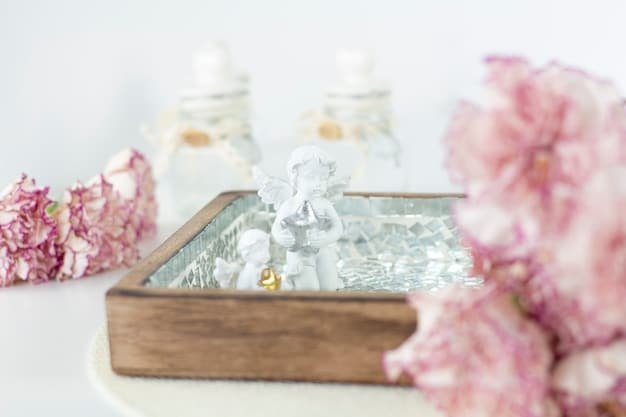The Science of Scent: A Deep Dive into How Perfume Works

Advertisements
The science of scent involves a complex interplay of chemistry, biology, and psychology, where different fragrance molecules interact with our olfactory receptors to create the unique experience we know as perfume.
Ever wondered how your favorite perfume manages to evoke such strong emotions and memories? The answer lies in the science of scent: understanding how perfume works goes beyond just a pleasant smell; it’s a complex interplay of chemistry, biology, and psychology that creates a unique and deeply personal experience.
Advertisements
The Intriguing Chemistry of Fragrances
The world of perfume begins with chemistry. Understanding the molecular makeup of fragrances and how these molecules interact is crucial to appreciating the art and science behind creating a scent.
The Building Blocks: Scent Molecules
Perfumes are composed of various scent molecules, each with a unique structure and odor profile. These molecules are typically organic compounds that are volatile, meaning they evaporate easily and can be carried through the air to reach our noses.
Advertisements
The Art of Blending: Accords and Notes
Creating a perfume is like composing a symphony. Perfumers, often referred to as “noses,” carefully blend different scent molecules to create harmonious accords. These accords are built upon three main notes: top notes, heart notes, and base notes.
- Top Notes: These are the initial, fleeting scents that you smell immediately after applying perfume. They are typically light and fresh, such as citrus or herbal notes.
- Heart Notes: These emerge as the top notes fade and form the core of the fragrance. They are often floral or spicy, giving the perfume its distinctive character.
- Base Notes: These are the long-lasting, grounding scents that linger on the skin. They are typically woody, musky, or vanilla-like, providing depth and longevity to the fragrance.
The careful selection and blending of these notes is what gives each perfume its unique and complex character.

In conclusion, perfume chemistry involves understanding the structure and behavior of scent molecules and skillfully blending them to create harmonious accords that evolve over time.
The Biology of Smell: How We Perceive Fragrance
Understanding the biology of smell is crucial to appreciating how perfumes interact with our senses. This involves exploring how our olfactory system works and how scent molecules are processed in the brain.
The Olfactory System: Our Scent Receptors
Our sense of smell begins with specialized receptors in our nasal cavity. These olfactory receptors are located on olfactory receptor neurons, which are responsible for detecting scent molecules in the air.
The Journey of Scent: From Nose to Brain
When we inhale, scent molecules travel through the nasal passages and bind to specific olfactory receptors. This binding triggers an electrical signal that is transmitted along the olfactory nerve to the olfactory bulb in the brain.
- Olfactory Bulb: The olfactory bulb is the primary processing center for smells. It relays signals to other brain regions involved in emotion, memory, and behavior.
- Limbic System: The limbic system, including the amygdala and hippocampus, is closely connected to the olfactory bulb. This connection helps explain why certain scents can evoke strong emotional responses and memories.
- Cerebral Cortex: The cerebral cortex, particularly the orbitofrontal cortex, is involved in the conscious perception and identification of smells.
This intricate biological process allows us to perceive and interpret the complex array of scents in our environment, including the fragrances in perfumes.
In short, the biological process of smell involves a complex interplay of receptors, nerves, and brain regions that translate scent molecules into meaningful perceptions and emotional responses.
The Psychology of Scent: Memory and Emotion
The influence of scent extends far beyond mere pleasantness. Scents have a profound impact on our memories, emotions, and even our behavior.
Scent and Memory: The Proustian Phenomenon
The connection between scent and memory is well-documented. Marcel Proust famously described how the scent of a madeleine dipped in tea evoked a flood of childhood memories, a phenomenon now known as the “Proustian effect.”
Scent and Emotion: The Power of Fragrance
Scents can have a powerful impact on our emotions. Certain fragrances can evoke feelings of relaxation, happiness, or even nostalgia. This is because the olfactory bulb is directly connected to the limbic system, which is involved in processing emotions.
Understanding the psychological impact of scents helps explain why perfumes are so closely associated with personal identity and expression.
In brief, the science of scent extends into the psychological realm, influencing our memories, emotions, and behaviors in ways that are both subtle and profound.
The Art of Perfume Creation: From Inspiration to Bottle
Creating a perfume is both an art and a science. Perfumers draw on their knowledge of chemistry, biology, and psychology to craft fragrances that are both beautiful and meaningful.
The Perfumer’s Palette: Raw Materials and Techniques
Perfumers have a vast array of raw materials at their disposal, including natural extracts, synthetic molecules, and various blending techniques. They use these materials to create unique and complex fragrance compositions.
The Creative Process: Inspiration and Experimentation
The creative process of perfume creation varies from perfumer to perfumer. Some draw inspiration from nature, art, or personal experiences, while others rely on experimentation and intuition.
Regardless of the approach, the goal is to create a fragrance that tells a story, evokes an emotion, or captures a particular moment in time.
Perfume Families and Characteristics
Perfumes are often classified into different families based on their dominant characteristics. These families provide a framework for understanding the broad range of fragrance styles available.
Floral
Floral perfumes are characterized by their prominent floral notes, such as rose, jasmine, lily, or tuberose. These fragrances are often feminine and romantic.
Woody
Woody perfumes are characterized by their warm, earthy notes, such as sandalwood, cedarwood, vetiver, or patchouli. These fragrances are often masculine and sophisticated.
Oriental
Oriental perfumes are characterized by their rich, spicy, and exotic notes, such as amber, vanilla, cinnamon, or clove. These fragrances are often warm, sensual, and mysterious.
Fresh
Fresh perfumes are characterized by their light, clean, and invigorating notes, such as citrus, aquatic, or green notes. These fragrances are often unisex and refreshing.
Understanding these perfume families can help you navigate the world of fragrance and find scents that align with your personal preferences.
Choosing the Right Perfume: Personal Preference and Skin Chemistry
Choosing the right perfume is a personal and subjective experience. Factors such as personal preference, skin chemistry, and lifestyle can all influence how a perfume smells and performs on your skin.
Testing Perfumes: On Skin vs. Paper
When testing perfumes, it’s important to apply them to your skin rather than just smelling them on a paper strip. This is because your skin’s natural chemistry can interact with the fragrance and alter its scent profile. Allow the perfume to develop on your skin for several hours to fully experience its top, heart, and base notes.
Considering Occasion and Season
The occasion and season can also influence your perfume choice. Lighter, fresher scents are often more appropriate for daytime wear and warmer weather, while richer, warmer scents are better suited for evening wear and cooler weather.
| Key Concept | Brief Description |
|---|---|
| 🧪 Scent Molecules | Volatile organic compounds that evaporate easily. |
| 👃 Olfactory System | Detects and transmits signals to the brain. |
| 🧠 Limbic System | Connects scent to emotions and memories. |
| 🌸 Perfume Families | Classifications based on dominant characteristics. |
Frequently Asked Questions
▼
The main components are top notes (initial scents), heart notes (core scents), and base notes (long-lasting scents). These work together to create the fragrance’s overall profile.
▼
Scent molecules bind to receptors in the nasal cavity, sending signals to the olfactory bulb. This then relays information to the limbic system and cerebral cortex for perception.
▼
Skin chemistry, including pH levels and natural oils, can interact with the fragrance molecules, altering the scent profile. This results in a unique smell for each wearer.
▼
The main families include floral, woody, oriental, and fresh. Each family has distinct characteristics and appeals to different preferences.
▼
Apply the perfume to your skin and allow it to develop for several hours. This allows you to experience the top, heart, and base notes, ensuring it aligns with your preferences.
Conclusion
Understanding the science of scent: understanding how perfume works reveals a fascinating world of chemistry, biology, and psychology, blending to create experiences that are unique and intensely personal. From the meticulous selection of scent molecules to the complex neurological pathways that interpret those scents, perfumes are more than just pleasant aromas, they are a profound reflection of our memories, emotions, and identities.